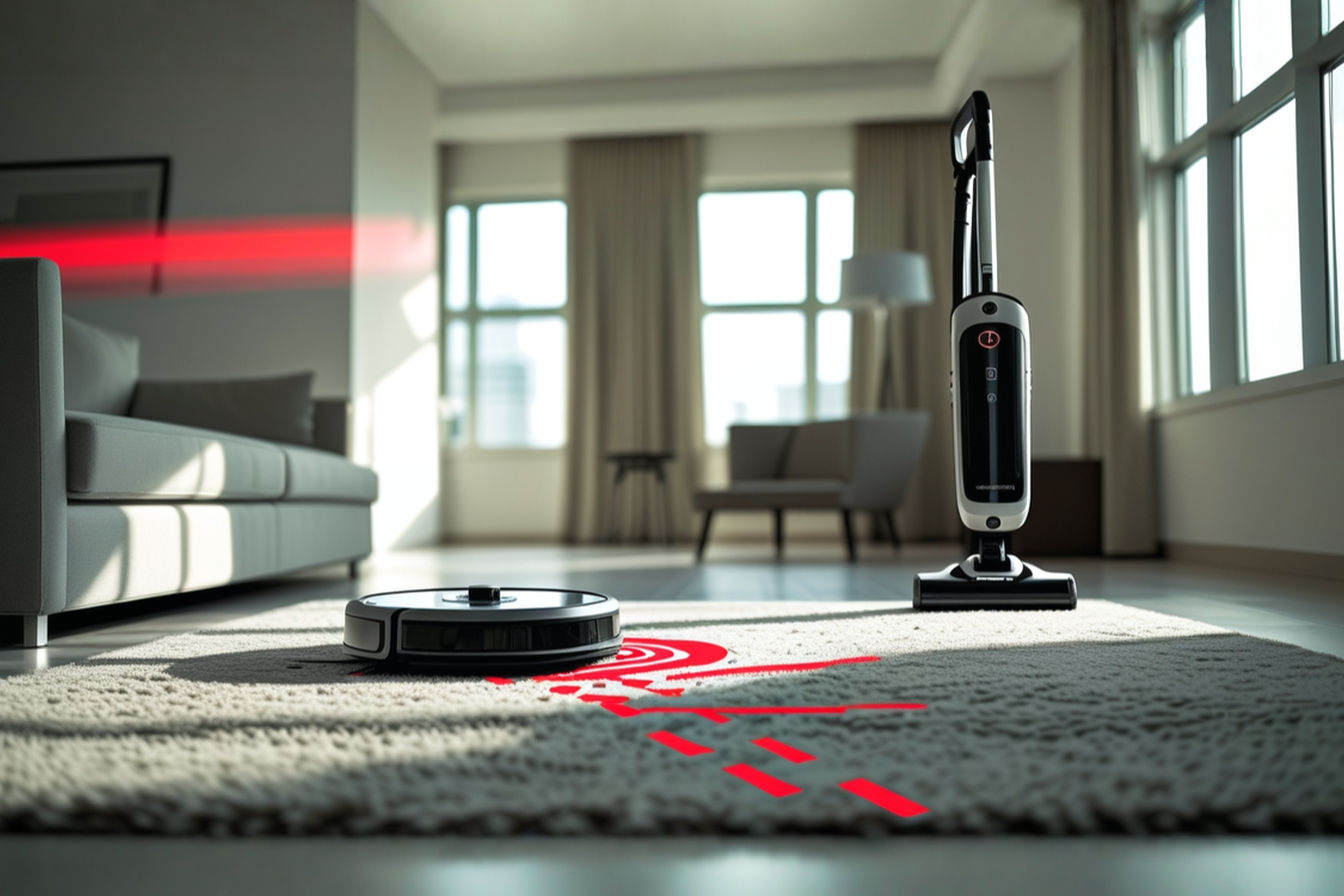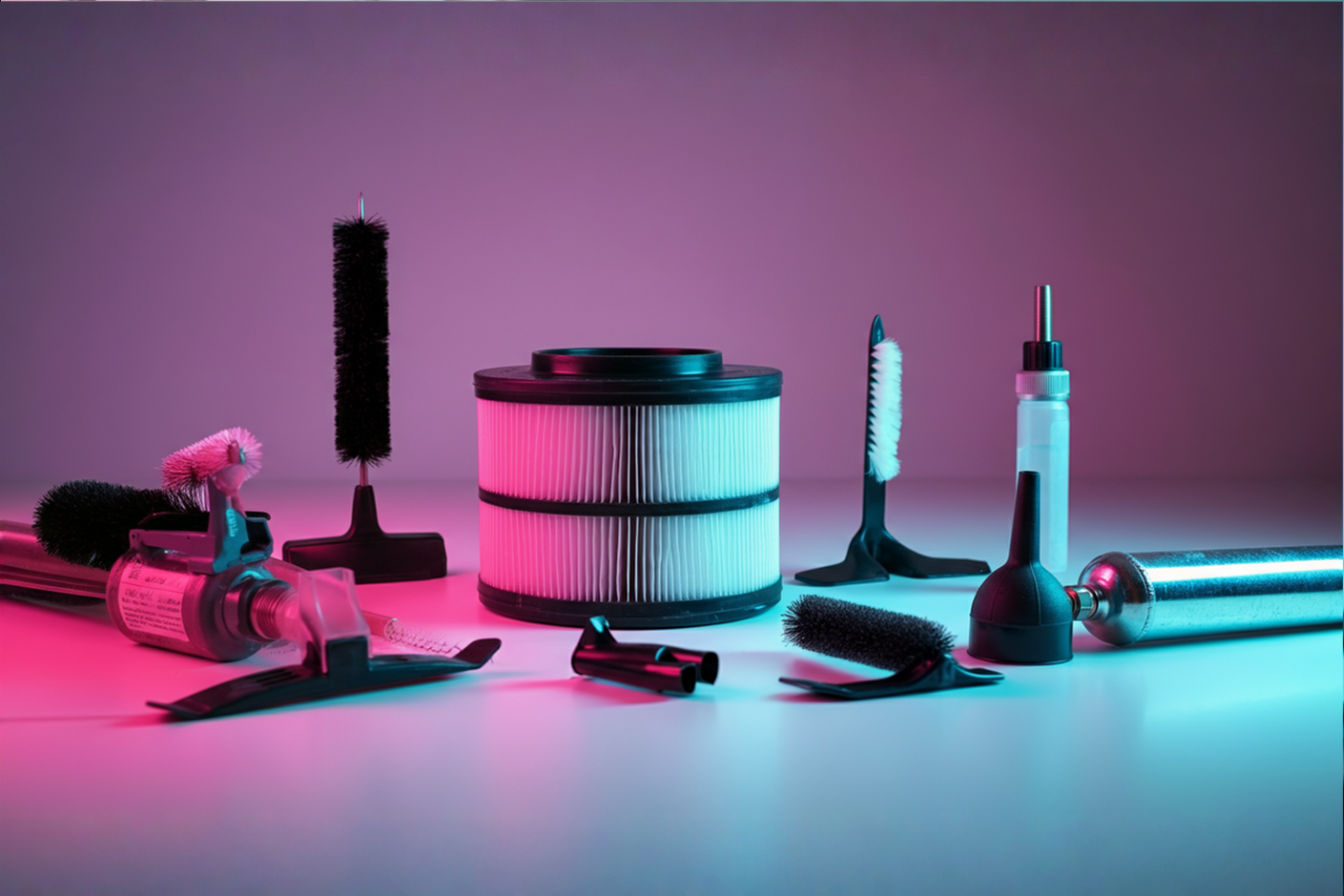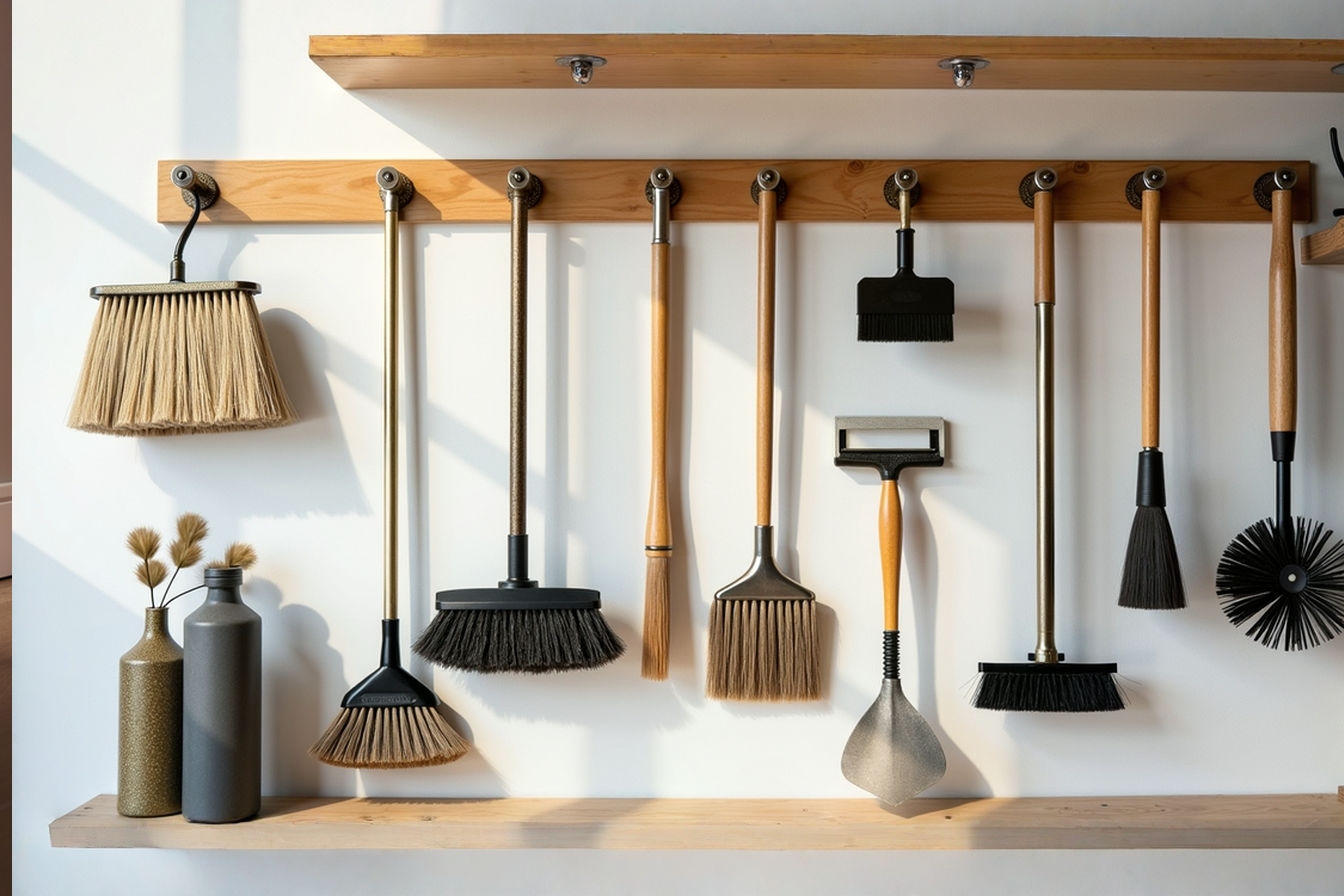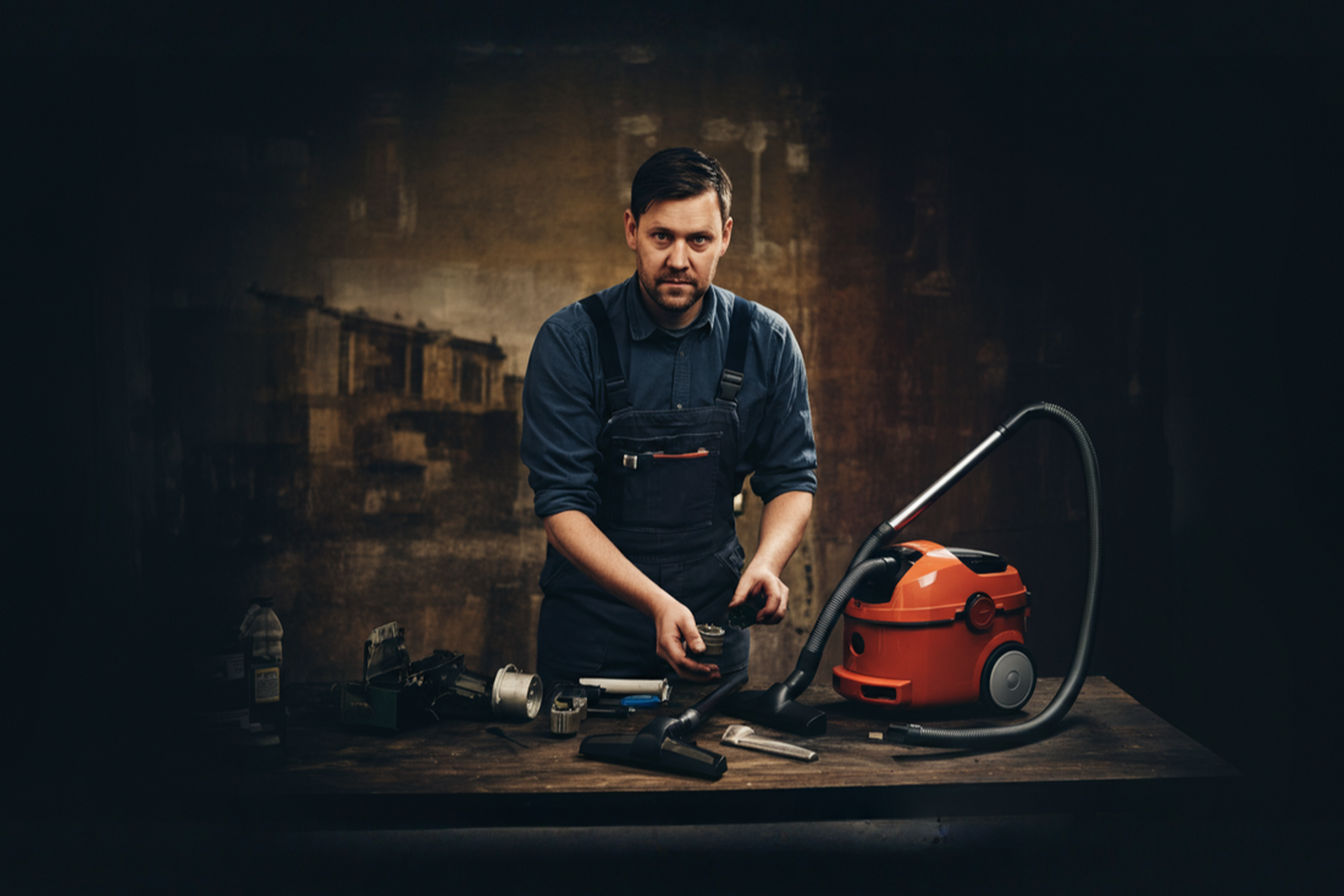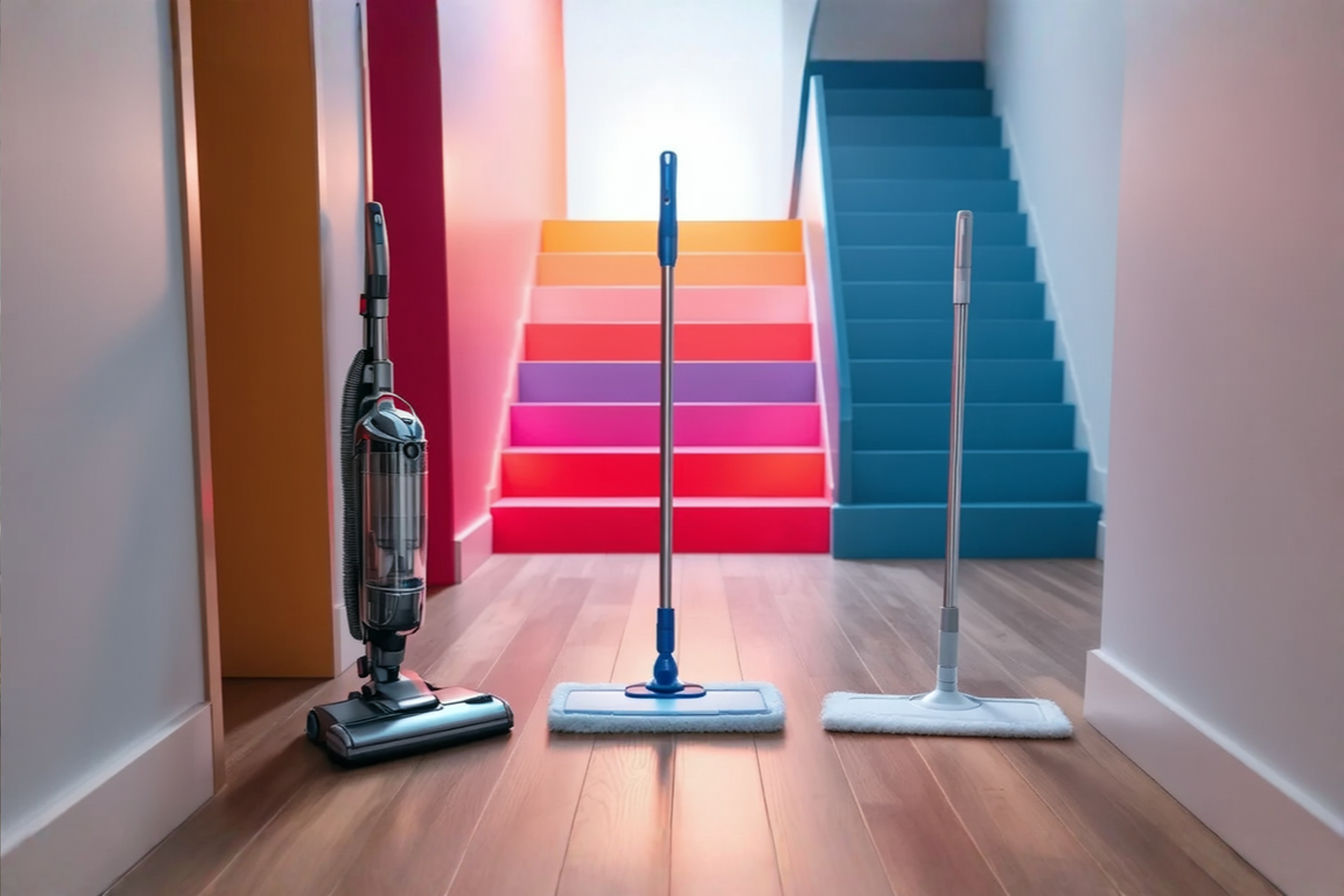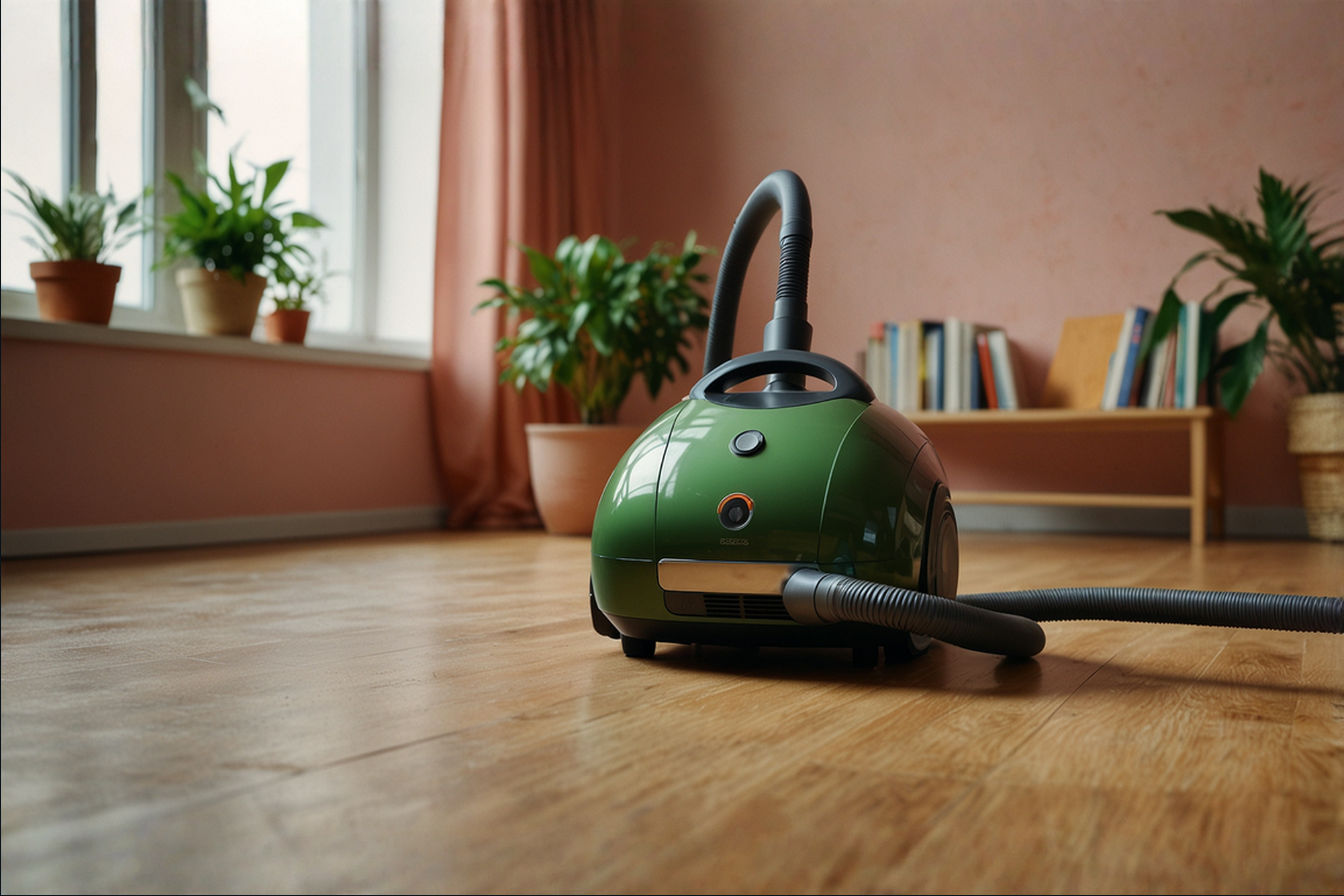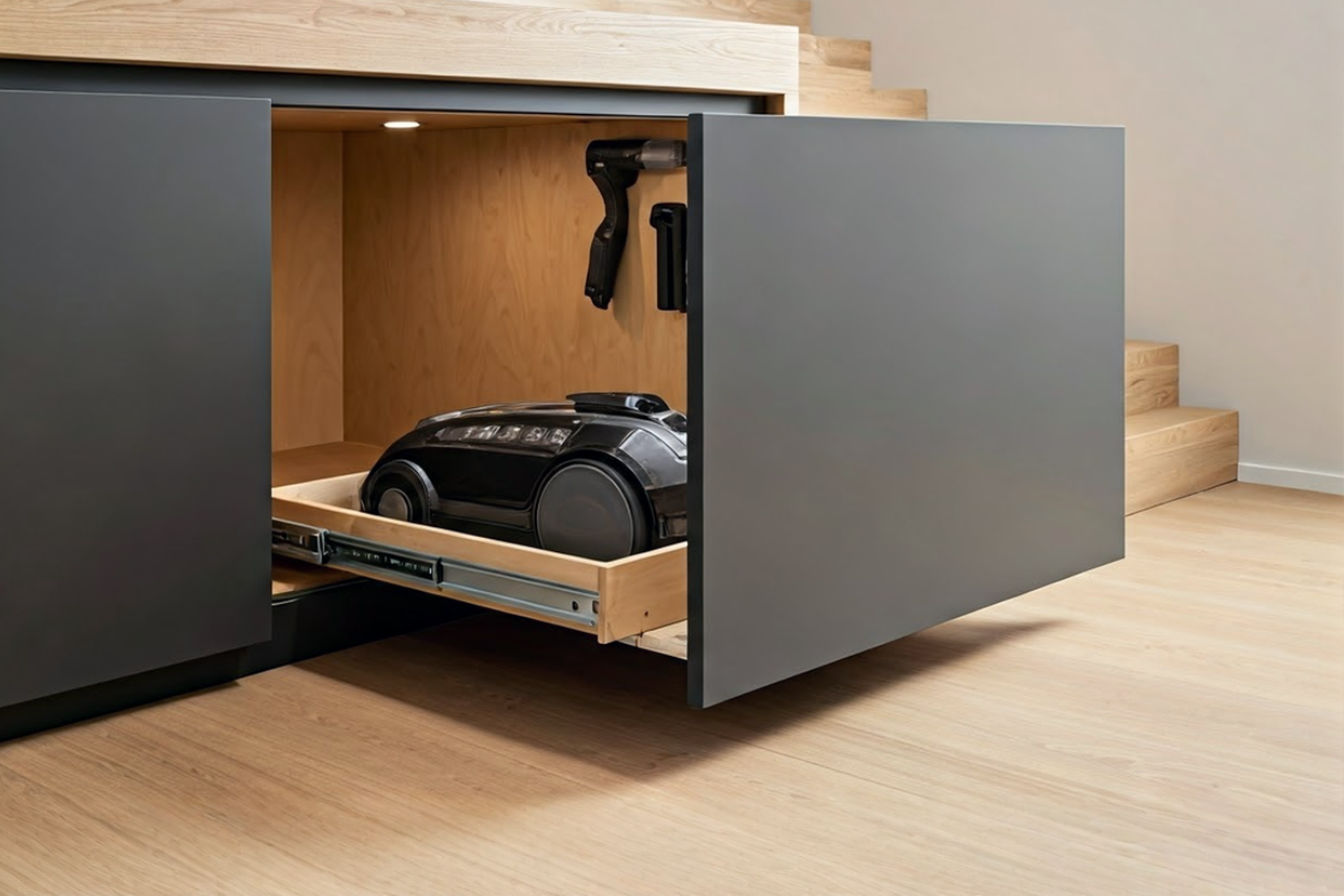Multi-Device Cleaning Choreography: Coordinating Robot and Stick Vacuums
Discover how to transform your robot and stick vacuums from isolated tools into a coordinated cleaning system that maintains your home with unprecedented efficiency and effectiveness.
This post may contain affiliate links. If you make a purchase through these links, we may earn a commission at no additional cost to you.
In today’s fast-paced world, keeping our homes clean has become an intricate dance of technology and timing. Modern households increasingly rely on multiple cleaning devices, each with specialized functions, to maintain pristine living spaces while minimizing hands-on effort. The coordination of these devices—particularly robot vacuums and stick vacuums—represents a new frontier in home maintenance that we call “multi-device cleaning choreography.”
This choreography isn’t simply about owning multiple cleaning tools; it’s about orchestrating their operations in harmony to achieve superior results with minimal human intervention. When robot and stick vacuums work in tandem, they compensate for each other’s limitations and amplify their respective strengths, creating a comprehensive cleaning system greater than the sum of its parts.
Smart coordination between these devices offers remarkable benefits: reduced cleaning time, improved thoroughness, extended equipment lifespan, and ultimately, a consistently cleaner home with less manual effort. The right choreography transforms these individual tools into a cohesive cleaning ecosystem that adapts to your home’s unique needs.
This guide will walk you through the art and science of coordinating your cleaning devices. You’ll discover how to assess your home’s specific requirements, create efficient cleaning schedules, leverage smart technology for seamless integration, and troubleshoot common coordination challenges. Whether you’re a tech enthusiast with multiple smart devices or simply seeking to maximize efficiency between your basic robot helper and traditional stick vacuum, this comprehensive approach will revolutionize your cleaning routine.
Understanding Your Cleaning Arsenal
Before choreographing your cleaning devices, you must understand the distinct capabilities each brings to your home maintenance strategy. This knowledge forms the foundation for creating truly effective coordination.
Robot Vacuum Capabilities and Limitations
Robot vacuums excel at maintaining cleanliness through regular, automated sweeps of your home. These devices shine in their ability to work independently, following programmed paths or responding to dirt sensors to provide consistent cleaning on schedules you determine. Advanced models offer impressive mapping capabilities, remembering room layouts and avoiding obstacles with increasing precision.
However, these automated assistants have inherent constraints. They struggle with high-pile carpets, dark surfaces that confuse sensors, and tight spaces like corners or under certain furniture. Their suction power, while improving with each generation, typically doesn’t match that of manual vacuums. Many models also face challenges with larger debris, pet hair accumulation, and multi-level homes unless specifically designed with these considerations in mind.
Stick Vacuum Strengths and Weaknesses
In contrast, modern stick vacuums deliver exceptional suction power in a lightweight, maneuverable package. Their directed cleaning ability allows you to target specific areas, address visible dirt immediately, and reach spaces robots simply cannot access. The precision of human-controlled operation means nothing escapes attention when using these devices properly.
The primary drawback of stick vacuums lies in their reliance on human operation, making them time-intensive tools that require direct attention. Battery life often limits cleaning sessions, and even the lightest models can cause fatigue during extended use. Additionally, they lack the scheduling convenience that makes robot vacuums so appealing for regular maintenance.
Complementary Functions of Both Devices
The magic happens when these devices work complementarily. Your robot vacuum provides consistent baseline cleanliness through regular scheduled runs, handling the broad surfaces and maintaining day-to-day tidiness. The stick vacuum then becomes your precision tool for targeted cleaning—addressing high-traffic areas, tackling corners and edges, and managing situations requiring immediate attention.
This partnership creates a comprehensive system where the robot handles routine maintenance while the stick vacuum addresses exceptions and specialized needs. Together, they provide complete coverage that neither could achieve independently.
Technology Compatibility Considerations
When building your multi-device cleaning system, technological compatibility becomes crucial. Modern cleaning devices increasingly offer connectivity features that enhance coordination possibilities. Consider whether your devices share ecosystem compatibility—can they be controlled through the same app or smart home system? Do they communicate with each other directly?
Even without direct communication capabilities, devices from the same manufacturer often share design philosophies that facilitate better coordination. Features like similar bin designs, filter systems, or battery technologies can streamline maintenance and simplify your overall cleaning routine. These compatibility factors significantly impact how seamlessly your devices will work together in your choreographed cleaning system.
Mapping Your Home for Strategic Cleaning
Creating an effective multi-device cleaning choreography requires a comprehensive understanding of your living space. Strategic mapping helps identify the specific needs of different areas and determines which device handles each zone most effectively.
Room-by-Room Assessment
Begin by evaluating each room individually, noting its unique characteristics and cleaning requirements. Consider flooring types, as hardwood, tile, and various carpet densities respond differently to cleaning approaches. Measure furniture density and placement, identifying tight spaces and open areas. Note fixed obstacles like kitchen islands or bathroom fixtures that create permanent cleaning challenges.
This assessment should also identify special conditions like high-soil areas near entrances, pet feeding stations, or children’s play zones. These spaces often require enhanced attention and may benefit from specific device assignments within your choreography. Document these observations systematically, creating a personalized cleaning profile for each room in your home.
Traffic Patterns and Cleaning Zones
Human movement through your home creates predictable soil patterns that smart cleaning choreography must address. Main walkways typically accumulate more dirt and require more frequent attention than peripheral areas. Entryways face continuous outside contamination, while hallways channel foot traffic and associated debris throughout the home.
Divide your home into zones based on these patterns, creating a hierarchy of cleaning needs. High-traffic zones need frequent attention from both devices, while moderate-traffic areas might receive regular robot cleanings with occasional stick vacuum follow-ups. Low-traffic zones may require only periodic attention from either device. This zoning approach allows you to allocate your cleaning resources precisely where they’ll provide maximum benefit.
Identifying Robot-Friendly vs. Stick-Required Areas
Some spaces naturally favor one cleaning device over another. Robot-friendly areas typically feature open layouts, consistent flooring surfaces, minimal obstacles, and limited elevation changes. These spaces allow your automated assistant to operate at peak efficiency with minimal intervention.
Stick-required areas include spaces with numerous obstacles, tight corners, delicate objects, significant elevation changes, or specialized surfaces. Stairs, crowded bookshelves, under low furniture, and areas with delicate items require the control and precision that only a human-operated stick vacuum can provide. Mapping these distinctions throughout your home creates clear operational boundaries for each device.
Creating Digital and Physical Maps
Transform your assessment into actionable maps that guide your cleaning choreography. Many premium robot vacuums create digital floor plans during operation, which you can enhance by defining room boundaries, no-go zones, and cleaning priorities within the companion app. Supplement these digital tools with physical preparations like moving charging stations to strategic locations and minimizing cord hazards.
For homes without mapping-capable robots, create your own visual reference by sketching floor plans that indicate device assignments, traffic patterns, and cleaning frequencies for each area. This mapping exercise transforms abstract cleaning plans into concrete strategies that inform your device coordination and scheduling decisions.
Creating Your Cleaning Choreography
With a clear understanding of your tools and spaces, you can now design the actual choreography that orchestrates their movements. This systematic approach ensures each device contributes optimally to your home’s cleanliness.
Defining Primary and Secondary Cleaning Roles
Establish a clear hierarchy for your cleaning devices based on their strengths and your home’s needs. In most multi-device systems, the robot vacuum serves as the primary maintenance cleaner, handling routine dust and debris removal across accessible areas. Its consistent operation maintains baseline cleanliness throughout the home.
The stick vacuum typically assumes a secondary role focused on precision cleaning and exception handling. This includes addressing areas the robot cannot reach, managing unexpected messes, and providing deeper cleaning during scheduled intensive sessions. This role definition prevents redundant effort while ensuring complete coverage across all surfaces.
Some households benefit from reversing these roles in specific zones. For instance, homes with primarily plush carpeting might rely more heavily on the stick vacuum for those surfaces while letting the robot focus on hard floors. The key is creating clear purpose for each device rather than having them randomly overlap in functionality.
Scheduling Principles for Multiple Devices
Effective scheduling transforms random cleaning events into a cohesive system. Begin by establishing a baseline frequency for complete home cleaning, typically ranging from daily sweeps in homes with pets or allergies to twice-weekly maintenance in lower-traffic households. Within this framework, create a rotation that addresses high-priority zones more frequently than low-traffic areas.
Time-block your device usage to minimize conflicts and maximize efficiency. For example, program robot vacuums to operate during work hours when the home is empty and floors are clear, reserving evening time for targeted stick vacuum sessions addressing the day’s new debris. Align these schedules with natural household rhythms like meal preparation, work departures, or children’s activities to minimize disruption.
Consider cleaning intensity in your scheduling as well. Light maintenance cleanings can occur more frequently with minimal disruption, while deep cleaning sessions involving both devices might be reserved for weekly or monthly slots with dedicated time allocated.
Sequential vs. Simultaneous Operation
Determine whether your devices should operate in sequence or simultaneously in different zones. Sequential operation typically involves the robot vacuum completing its cycle before you follow up with the stick vacuum, creating a two-stage cleaning process where the automated device handles broader surfaces before you address the details.
Simultaneous operation works well in larger homes where you can operate the stick vacuum in one zone while the robot cleans another, effectively doubling your cleaning coverage within a given timeframe. This approach requires careful planning to avoid interference between devices but can significantly reduce total cleaning time.
Most effective choreographies incorporate both approaches, using simultaneous cleaning for routine maintenance and sequential operation for more thorough cleaning sessions. The right balance depends on your home’s layout, your schedule flexibility, and the specific capabilities of your devices.
Seasonal Cleaning Pattern Adjustments
Your cleaning needs evolve throughout the year, requiring corresponding adjustments to your device choreography. Winter months often introduce more tracked-in debris near entryways, while spring pollen season may necessitate more frequent air filter maintenance in both devices. Summer typically brings increased indoor-outdoor traffic, while fall leaf season creates unique cleaning challenges.
Modify your cleaning zones, device priorities, and scheduling frequency seasonally to address these changing patterns. Additionally, align your choreography with special events and holidays that alter normal household activities. This adaptability ensures your cleaning system remains effective regardless of seasonal variations or exceptional circumstances.
Technology Integration for Seamless Coordination
Modern cleaning devices increasingly offer connectivity features that enhance coordination possibilities. Leveraging these technological capabilities creates a more integrated cleaning system with minimal manual oversight.
Smart Home Integration Options
The foundation of technology-enhanced cleaning choreography lies in smart home integration. Wi-Fi-enabled cleaning devices can connect to central platforms like Amazon Alexa, Google Home, or Apple HomeKit, allowing unified control of your entire cleaning arsenal. This integration enables consistent command language, simplified scheduling, and coordinated operation across devices regardless of manufacturer.
More advanced setups incorporate additional smart home elements to enhance cleaning effectiveness. Smart sensors can detect when specific areas need attention, automatically dispatching the appropriate device. Connected door sensors can trigger entryway cleaning after prolonged opening, while smart pet feeders might activate robot vacuum sweeps after mealtime messes.
Select platforms and devices with open APIs and broad compatibility to future-proof your system as you add or replace components. This forward-thinking approach ensures your cleaning choreography remains cohesive even as individual devices change over time.
App-Based Control Systems
Manufacturer apps serve as the command center for most connected cleaning devices, offering granular control over operation. These platforms typically allow detailed scheduling, cleaning mode selection, and zone-specific instructions that form the backbone of your choreography.
When possible, consolidate control within a single application. Some manufacturers offer unified platforms that manage both robot and stick vacuums, creating seamless coordination opportunities. For devices from different manufacturers, third-party automation platforms like IFTTT (If This, Then That) or Stringify can bridge communication gaps, allowing disparate devices to work together more effectively.
Explore the full depth of your control applications, as many offer underutilized features like maintenance reminders, cleaning statistics, and consumable tracking that enhance your overall system efficiency. Regular app updates often introduce new coordination capabilities, making periodic feature reviews worthwhile.
Voice Command Coordination
Voice assistants add a layer of convenience to your cleaning choreography, allowing real-time adjustments without physical interaction. Basic voice commands enable immediate cleaning activations when unexpected messes occur—simply instructing “Clean the kitchen” can dispatch the appropriate device without interrupting your current activities.
More sophisticated voice implementations allow complex command sequences that orchestrate multiple devices. Commands like “Start weekly cleaning routine” can activate predetermined sequences involving both robot and stick vacuums following your choreographed plan. This hands-free control proves particularly valuable when managing cleaning operations while cooking, childcare, or other household activities demand your attention.
To maximize voice control effectiveness, create consistent naming conventions for devices and cleaning routines. Simple, intuitive names ensure reliable voice recognition and create a more natural interaction experience when managing your cleaning system.
Automation Rules and Triggers
Advanced cleaning choreography utilizes conditional logic to create truly responsive cleaning systems. Automation rules connect specific triggers to predetermined cleaning actions, allowing your system to react independently to changing household conditions.
Common automation examples include scheduling robot vacuum runs after detecting everyone has left the house, activating targeted cleaning when motion sensors identify activity in specific rooms, or initiating special cleaning routines when weather apps indicate high pollen counts or muddy conditions. These context-aware responses ensure your cleaning system addresses real-time needs without constant manual adjustment.
Start with simple automations focused on scheduling before progressing to more complex conditional responses. This gradual approach helps you understand how automations impact your overall system and allows fine-tuning before adding additional complexity to your cleaning choreography.
Optimizing Multi-Device Cleaning Efficiency
Creating an efficient multi-device cleaning system involves more than scheduling and technology—it requires thoughtful preparation, maintenance planning, and resource management to ensure consistent performance.
Prep Work for Maximum Efficiency
The effectiveness of any cleaning choreography depends significantly on pre-cleaning preparation. Establish routine habits that make your spaces “robot ready” by managing common obstacles like cords, small objects, and lightweight rugs before scheduled cleanings. Train household members to participate in quick prep sessions—even children can help by picking up toys or securing items that might impede automated cleaning.
Design your spaces with cleaning efficiency in mind. Consider furniture with adequate clearance for robot vacuums, cord management solutions that minimize entanglement risks, and storage systems that keep floors clear of obstacles. These environmental optimizations drastically reduce intervention requirements and allow your automated assistants to operate at peak efficiency.
For manual cleaning components, prepare tool stations with your stick vacuum and accessories positioned strategically throughout the home. These ready positions minimize transition time when switching to manual cleaning tasks and encourage more frequent touch-up cleaning when tools are conveniently accessible.
Maintenance Scheduling for Both Devices
Consistent performance requires regular maintenance for all cleaning devices. Incorporate maintenance tasks directly into your cleaning choreography, creating a comprehensive system that preserves equipment functionality while maintaining home cleanliness.
Develop staggered maintenance schedules that prevent simultaneous downtime across devices. When your robot vacuum requires brush cleaning or filter replacement, ensure your stick vacuum remains fully operational to maintain cleaning continuity. This alternating approach ensures you always have functional cleaning capacity regardless of maintenance needs.
Track consumable usage and replacement cycles for both devices, maintaining appropriate supplies of filters, brushes, and other components that require regular replacement. Many connected devices offer automatic maintenance reminders based on usage patterns, but supplementing these with your own tracking provides additional reliability, especially for non-connected components.
Battery Management Strategies
Power management significantly impacts cleaning system reliability, particularly for cordless devices. Design your choreography with battery limitations in mind, scheduling cleaning sessions that align with each device’s operational capacity. Most robot vacuums return automatically to charging stations when depleted, but stick vacuums require manual recharging that must be incorporated into your planning.
For homes with extensive cleaning requirements, consider secondary batteries for stick vacuums to extend operational capacity. Maintain these in ready-to-use condition with charging stations positioned near high-use areas for quick swapping during intensive cleaning sessions.
Implement battery-preserving practices like using appropriate power modes for different tasks rather than constantly operating at maximum suction. This targeted approach extends runtime while maintaining cleaning effectiveness and prolonging overall battery lifespan across all devices.
Storage and Charging Station Placement
Strategic positioning of cleaning tools and charging infrastructure creates an environment that supports efficient choreography. Position robot vacuum charging stations in central, accessible locations that minimize travel distance while remaining discreet within your home design. Consider proximity to high-traffic areas that benefit from frequent cleaning while avoiding locations that create obstacles to normal household movement.
For stick vacuums and accessories, create dedicated storage locations that maintain battery conditioning while keeping tools accessible for immediate use. Wall-mounted docks in utility areas or closets provide organized storage while ensuring batteries remain charged and ready for use when needed.
In larger homes, consider distributed storage with cleaning tools positioned in multiple locations based on usage patterns. This approach reduces retrieval time and encourages more frequent quick-cleaning interventions when tools are readily available near commonly soiled areas.
Advanced Choreography Techniques
Once you’ve established basic coordination between your cleaning devices, advanced techniques can further enhance system performance and address specialized situations that arise in complex households.
Multi-Floor Coordination Strategies
Homes with multiple levels present unique choreography challenges requiring thoughtful device deployment. For homes with robot vacuums capable of floor recognition and mapping, create distinct cleaning plans for each level with appropriate intensity and frequency based on usage patterns. Schedule these operations sequentially to maintain consistent attention across all areas.
When using robots without multi-floor mapping, consider dedicated devices for different levels if budget allows, eliminating the need for manual relocation. Alternatively, create transport schedules that systematically move single devices between floors on predetermined days, ensuring every level receives regular attention without daily repositioning.
The stick vacuum becomes particularly valuable in multi-floor homes, addressing stairs and transition areas that robots cannot navigate. Include specific stairway cleaning sessions in your choreography, focusing on these connecting spaces that experience considerable traffic but remain inaccessible to automated cleaners.
Specialized Cleaning Events
Beyond regular maintenance, effective choreography addresses exceptional circumstances requiring intensified cleaning efforts. Create predefined routines for special events like dinner parties, holiday gatherings, or seasonal deep cleaning that temporarily increase cleaning frequency and intensity in relevant areas.
These event-based protocols might involve preliminary deep cleaning with both devices before guests arrive, robot vacuum operation during overnight hours following events, and targeted stick vacuum follow-up addressing specific areas of concern. Having these sequences predefined ensures consistent results without requiring complex planning during already busy periods.
Seasonal changes also necessitate specialized routines, particularly during high-allergen periods, shedding seasons for pets, or times when outdoor elements frequently enter the home. These temporary intensifications help manage exceptional circumstances without permanently increasing your regular cleaning burden.
Pet-Owner Adaptations
Homes with pets require specialized choreography adaptations to manage fur, dander, and tracked litter effectively. Identify pet-specific zones requiring enhanced attention, like areas surrounding litter boxes, feeding stations, or favorite resting spots. These zones typically benefit from increased robot vacuum frequency supplemented by regular stick vacuum deep cleaning.
Consider pet-specific cleaning tools like specialized brush rolls designed for hair collection, and integrate these with your standard equipment for targeted pet-area maintenance. Scheduling should account for pet routines, avoiding cleaning during feeding times or periods of high activity that might cause unnecessary stress to animals.
For homes with anxious pets, create alternative cleaning schedules that operate when pets are outdoors or in different rooms, minimizing exposure to devices that cause distress. This thoughtful coordination ensures both clean spaces and comfortable environments for all household members, including four-legged ones.
Family Involvement and Human-Device Coordination
The most sophisticated cleaning choreographies incorporate human activities rather than working around them. Identify opportunities for family participation that enhance system effectiveness without creating burdensome responsibilities. Simple habits like spot-cleaning visible debris before robot vacuum runs or repositioning furniture during seasonal cleaning can significantly improve outcomes with minimal effort.
Create clear responsibility divisions that leverage individual strengths and preferences. Tech-savvy family members might manage device programming and maintenance, while others contribute through preparation activities or manual cleaning components. This collaborative approach distributes workload while ensuring all necessary functions remain covered.
For households with children, incorporate age-appropriate cleaning responsibilities that complement your device choreography. Young children can help prepare spaces for robot operation by picking up toys, while older children might assist with stick vacuum operations in their personal spaces. This involvement not only improves cleaning outcomes but also builds lifelong habits of environmental maintenance.
Troubleshooting Common Coordination Issues
Even well-designed cleaning choreographies encounter occasional challenges. Developing systematic troubleshooting approaches ensures these issues cause minimal disruption to your overall cleaning system.
Device Conflict Resolution
When multiple devices operate in shared environments, conflicts inevitably arise. Physical interference may occur when robot paths intersect with areas needing stick vacuum attention. Resolve these conflicts through scheduled separation—creating time blocks that preserve distinct operational windows for each device in shared spaces.
Technical conflicts may emerge when devices compete for network resources or smart home system attention. These issues typically manifest as delayed responses, failed scheduling, or incomplete operations. Mitigate these challenges by staggering connection times, ensuring robust Wi-Fi coverage throughout cleaning areas, and updating firmware regularly to incorporate compatibility improvements.
Power conflicts arise when multiple devices require simultaneous charging or exceed electrical circuit capacities. Strategic charging station placement across different circuits prevents overloading, while staggered operation scheduling ensures devices recharge during separate time windows when possible.
Dealing with Missed Areas
Even sophisticated cleaning systems occasionally miss specific areas. Systematic detection and resolution prevent these exceptions from becoming persistent problems. Conduct periodic cleaning audits by physically inspecting areas after complete cleaning cycles, identifying any consistently missed spots requiring choreography adjustments.
When detection reveals missed locations, determine whether the issue stems from physical limitations, technical constraints, or scheduling inadequacies. Physical limitations might require furniture rearrangement or manual cleaning inclusion, while technical constraints might be resolved through mapping updates or virtual boundary adjustments.
Create specific remediation protocols for common missed areas like corners, under cabinets, or along baseboards. These targeted interventions can be scheduled less frequently than general cleaning while ensuring no area remains perpetually neglected within your overall system.
Technology Compatibility Problems
Technological evolution creates occasional compatibility challenges when devices, applications, or platforms receive updates. Maintain awareness of pending updates across your cleaning ecosystem, monitoring manufacturer announcements for potential compatibility impacts before installing new software.
When compatibility issues occur, prioritize resolution based on system impact. Critical functions like basic device operation take precedence over convenience features like voice control or detailed reporting. This prioritization ensures your cleaning choreography maintains fundamental effectiveness even when peripheral features experience temporary disruption.
Develop offline contingency protocols for periods when connectivity issues prevent normal operation. These manual override procedures ensure cleaning continuity during technical disruptions, maintaining your home’s cleanliness despite temporary technological limitations.
Adapting to Home Layout Changes
Household environments evolve through furniture rearrangement, renovation, or functional repurposing of spaces. These changes necessitate corresponding adjustments to your cleaning choreography. After significant layout modifications, initiate new mapping procedures for robot vacuums to capture current configurations accurately.
Evaluate whether layout changes affect device role assignments or zone classifications within your choreography. Areas previously designated for robot primary cleaning might require stick vacuum emphasis after introducing complex furniture arrangements, while previously challenging spaces might become more robot-accessible after simplification.
Use these adaptation points as opportunities to refine your overall choreography rather than simply accommodating single changes. Each environmental evolution provides valuable insights into system performance that can enhance efficiency throughout your cleaning ecosystem when properly incorporated.
Conclusion
Multi-device cleaning choreography represents the evolution of home maintenance—transforming isolated tools into coordinated systems that deliver superior results with minimal oversight. Through thoughtful integration of robot and stick vacuums, you’ve created a comprehensive approach that leverages each device’s strengths while compensating for individual limitations.
The systematic process outlined in this guide—understanding device capabilities, mapping your environment, creating structured schedules, leveraging technology, optimizing efficiency, implementing advanced techniques, and troubleshooting effectively—provides a framework for continuous cleaning system improvement. As you refine your choreography based on household experience, the system becomes increasingly personalized to your specific needs.
The future of home cleaning lies in this collaborative approach between automated tools and human oversight. Emerging technologies continue expanding coordination possibilities through enhanced sensing, improved communication protocols, and increasingly intelligent operation. Your current choreography establishes the foundation for incorporating these advancements as they become available.
Begin implementing these principles immediately, starting with basic device coordination before progressing to more sophisticated integration. Document your experiences, noting particularly effective combinations and areas needing refinement. This reflective approach transforms cleaning from repetitive drudgery into a continuously improving system that maintains your home with unprecedented efficiency.
By mastering multi-device cleaning choreography, you’ve not only created a cleaner living environment but also reclaimed valuable time for more meaningful activities. The ultimate measure of success isn’t just cleanliness—it’s the freedom that comes from automated systems handling routine maintenance while you focus on what truly matters in your life.

